
Warwan Valley Trek
TREK DIFFICULTY
Moderate - Difficult
TREK DURATION
9 Days
HIGHEST ALTITUDE
14,495 feet
GROUP SIZE
6-8
TREK DISTANCE
80
BASECAMP
Warwan Valley | Kashmir
BEST TIME
July to August
PICKUP POINT
Kashmir
Warwan Valley Trek Overview
A secluded and stunningly gorgeous valley called Warwan Valley may be found in Jammu and Kashmir, India's Kishtwar district. It is wonderful for those who love the outdoors and enjoy hiking because it is bordered by the magnificent Himalayan range. The village of Padum in Zanskar is the closest place to the valley, which is located there at a height of 7,500 feet above sea level. Warwan Valley is commonly referred to as the "Switzerland of India" because of its gorgeous alpine meadows, snow-capped hills, flowing streams, and scenic waterfalls. One of the most well-known treks in the area is the Warwan Valley trip, which offers an unparalleled experience of hiking through the pristine and uninhabited Himalayan environment.

Day 1: Drive from Srinagar to Panikhar(185 km, 7-8 hrs )
Day 2: Trek from Panikhar to Denora(12-13 km, 8 hrs)
Day 3: Trek from Denora to Kalapari(3 km, 2-3 hrs)
Day 4: Trek from Kalapari to Kaintal via Lomvilad Pass(17 km, 12-13 hrs)
Day 5: Trek from Kaintal to Humpet(17 km, 8 hrs)
Day 6: Trek from Humpet to Sukhnai(14 km, 8 hrs)
Day 7: Trek from Sukhnai to Basmina/Chaudraiman(16-17 km, 6-7 hrs)
Day 8: Buffer Day( Camping (Alpine Tents))
Day 9: Drive from Basmina/Chaudraiman to Srinagar(155 km, 7-8 hrs)
Day 10: Buffer Day
In Himalaya Shelter, we provide you with the option to customize your trekking experience. Whether you're a solo traveler, a group of friends, or a family, you can opt for our personalized tailor-made trekking program. This customized trek will be exclusively designed for you, taking into account your specific requirements for transportation, accommodation, meals, and any other premium facilities you may need during the trek. No other participants will be added to your group. Choosing a customized trek will enable you to fully enjoy the trek with your loved ones. Click here to learn what a customized trekking program looks like.
The journey starts in the hamlet of Inshan, which is 150 kilometers away from Srinagar. The walk travels beside the Warren River's banks and through lush stands of fir, pine, and deodar trees. It takes around 7-8 days to finish the walk to Warwan Valley, which is rated as fairly challenging. The path travels over around 80 kilometers and through several mountain peaks, such as the Margan Top and the Sonamoush Pass. Along with being a physical challenge, the trip offers a chance to take in stunning natural scenery. The distance from Pahalgam to Warwan Valley is approximately 120 kilometers. The distance from Kishtwar to Warwan Valley is approximately 40 kilometers. The distance from Anantnag to Warwan Valley is approximately 110 kilometers.
Throughout the trekking path, there are several historic temples and shrines in the Warwan Valley, which is likewise renowned for its extensive cultural legacy. The Machail Mata temple, a shrine to the Hindu goddess Durga, is the most well-known of them. The temple is located on a mountainside and is accessible from Gulabgarh, a tiny village close to the Warwan Valley, by a hard hike that takes around 30 kilometers. Warwan Valley is renowned for its kind and welcoming residents, in addition to its natural and cultural splendor. The Gujjars, Bakarwals, and Dogras, three ethnic groups that have been present in the valley for generations, are among the many ethnic groupings that call it home. In the isolated areas of the valley, these people's distinctive cultures and ways of life are still practiced. Trek to Warwan Valley has become a well-liked tourist activity in recent years, drawing visitors from all over the world. The valley is famed for its exquisite regional food, which includes delicacies like rajma rice, Kashmiri pulao, and rogan josh, as well as a variety of adventure sports including trekking, camping, and rock climbing.
Qualified and Experienced Trek Leaders
- Every trek leader at Himalaya Shelter is not only passionate about mountains but also highly qualified. They have done intensive training such as Basic Mountaineering Course, Advanced Mountaineering Course, Search and Rescue Course, and First Aid Course. This wide range of training prepares them with the required knowledge and experience to handle any situations that may come up while trekking.
- Our trek leaders have been to the trails multiple times before and know the local landscapes, weather conditions, and people well. You can trust that you are in capable hands with leaders who are not only passionate about the mountains but also equipped with the necessary expertise.
High Altitude Medical First Aid Kit
- The kit we provide consists of all necessary medical supplies and equipment for altitude trekking. From emergency first aid training to dealing with altitude-related symptoms so much more, we are ready to respond quickly to different medical situations.
- We know the difficulties of high altitude and to avoid any risks, we carry oxygen cylinders in every trek. This equipment proves to be a lifesaver in cases of altitude sickness or emergencies, giving instant relief to trekkers.
Small Group Sizes
- Our commitment to keeping group sizes small, with a maximum of 12 trekkers, is rooted in the belief that this approach enhances the overall safety and well-being of every participant. Thus making our trek leaders experts who provide individual attention to each trekker and ensure incident prevention and safety protocols are followed thereby creating a more engaging and enjoyable trekking experience.
High-Quality Equipment
- Himalaya Shelter is known for its high-quality trekking equipment and gear. From tents to safety harnesses, we make sure that all the equipment is of international safety standards and therefore reduce potential risks through the trek.
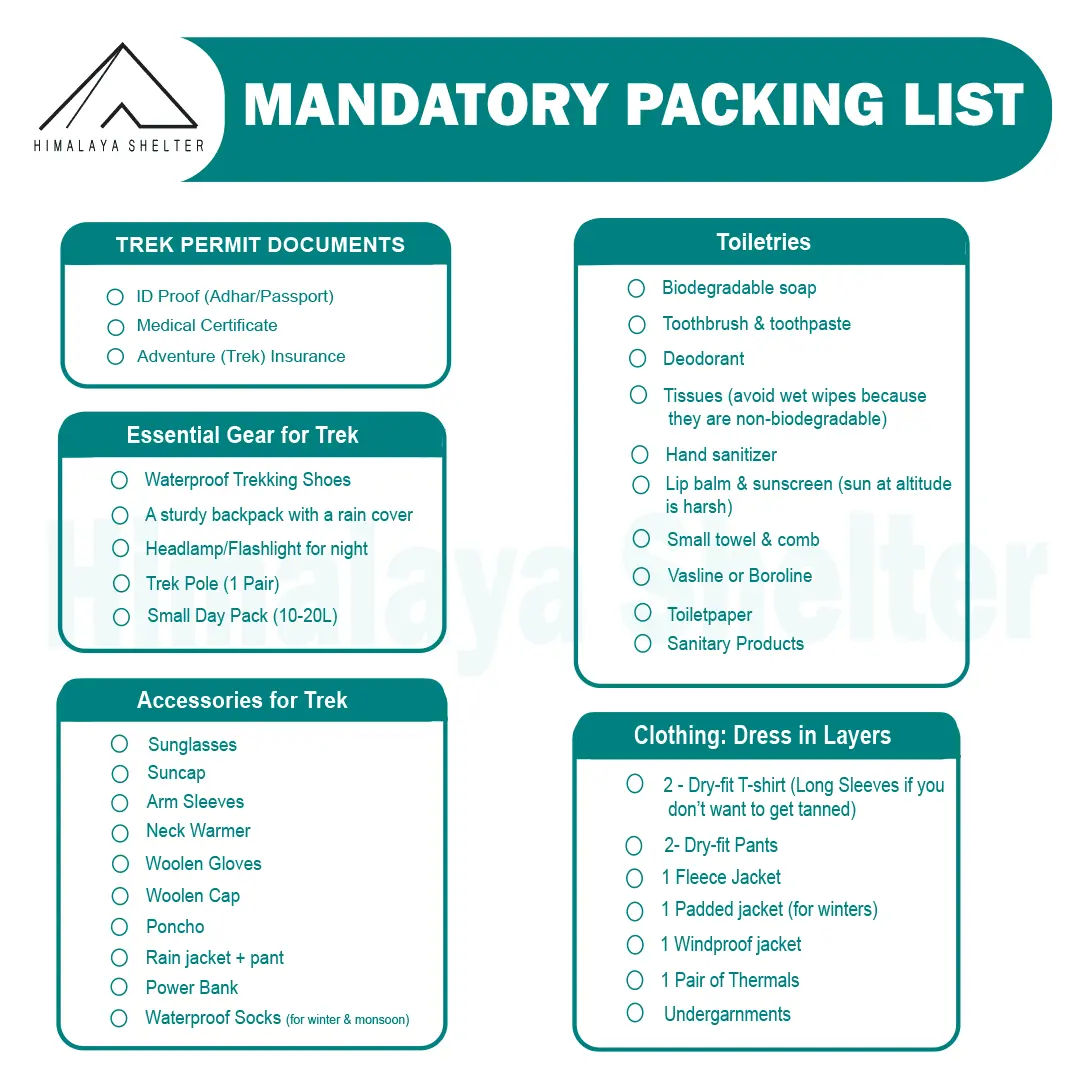
Mandatory Backpacking List for Aancha Top Trek
Clothing and Backpack
Get a good backpack (50 L) with a rain cover. Look for a bag that can provide you good back support. Pack 4 quick-dry t-shirts and 2 trekking pants. Get a pair of thermals (upper and lower) for night. Pack a fleece jacket or woolen sweater as a mid-layer. Get a waterproof wind breaker for sudden rain and chilly winds. For winter trekking, get a good down jacket. Now pack a woolen beanie and a balaclava. Get two pairs of gloves (woolen and waterproof). You should also pack a suncap for the daytime.
Footwear
You should look for good quality trekking shoes. Your shoes must be waterproof and provide good ankle support. Do not wear a new pair of shoes on the trek. Your feet must be familiar with the shoes. Now pack 4 pairs of trekking socks and 2 pairs of woolen socks. Pack a pair of comfortable slippers or sandals for the campsite.
Personal Care
For personal care items, start packing with your toiletries. Get a small zipper pouch and pack all the toiletries. Now look for a quick-dry towel and a toilet roll. You should also pack hand sanitizer and moisturizer. Pack a sunscreen that can protect your face from sunburn. You can also pack some snacks for the trek.
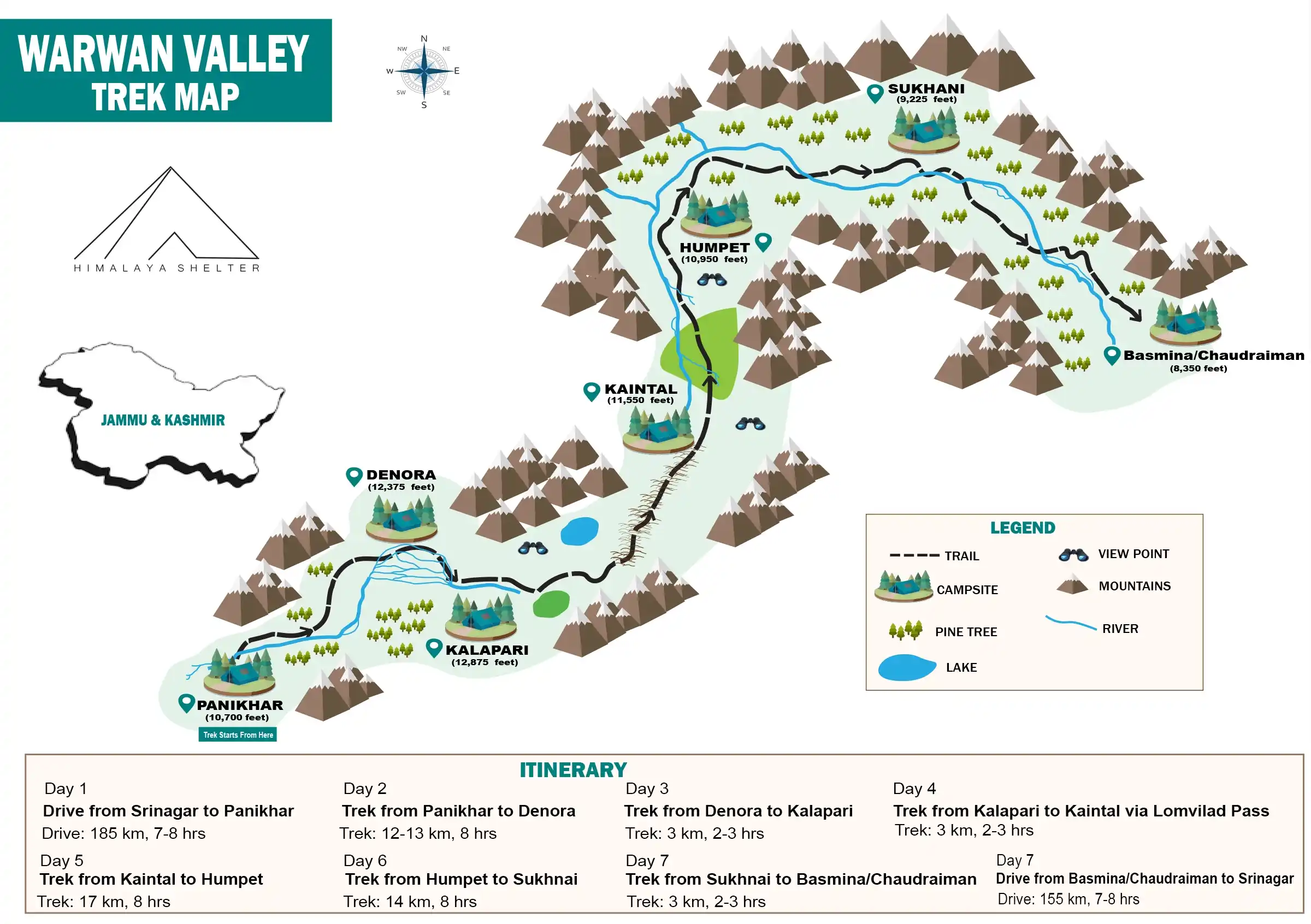
Physical Fitness Preparation for Trek:
To overcome the difficulty level of trekking, it requires strong cardiovascular endurance, muscular strength, and overall physical fitness. Incorporate these exercises into your routine to increase strength, stability, and stamina, which will help you tackle difficult terrain sections of the trail at high altitudes.
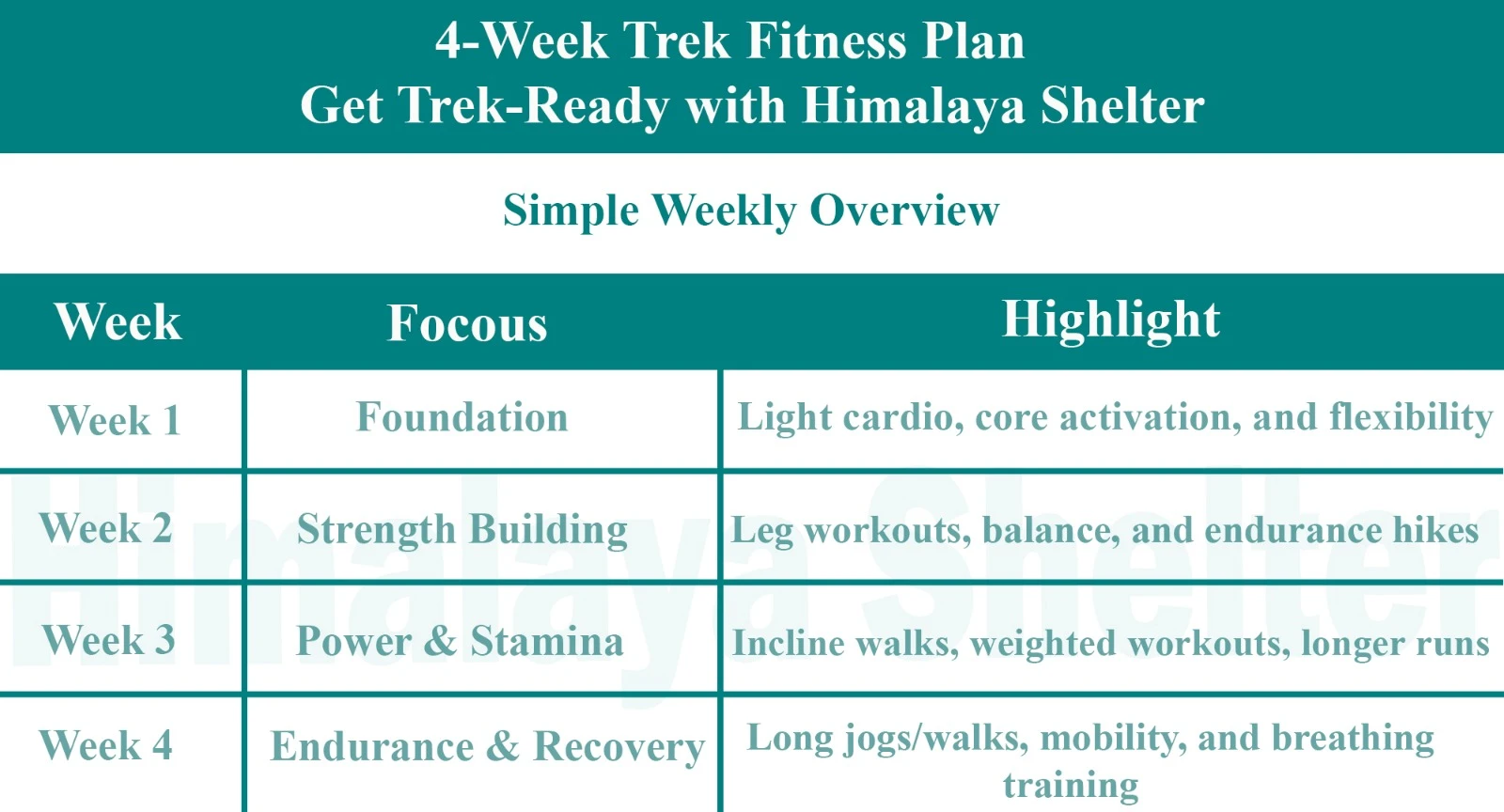
Overview

Foundation
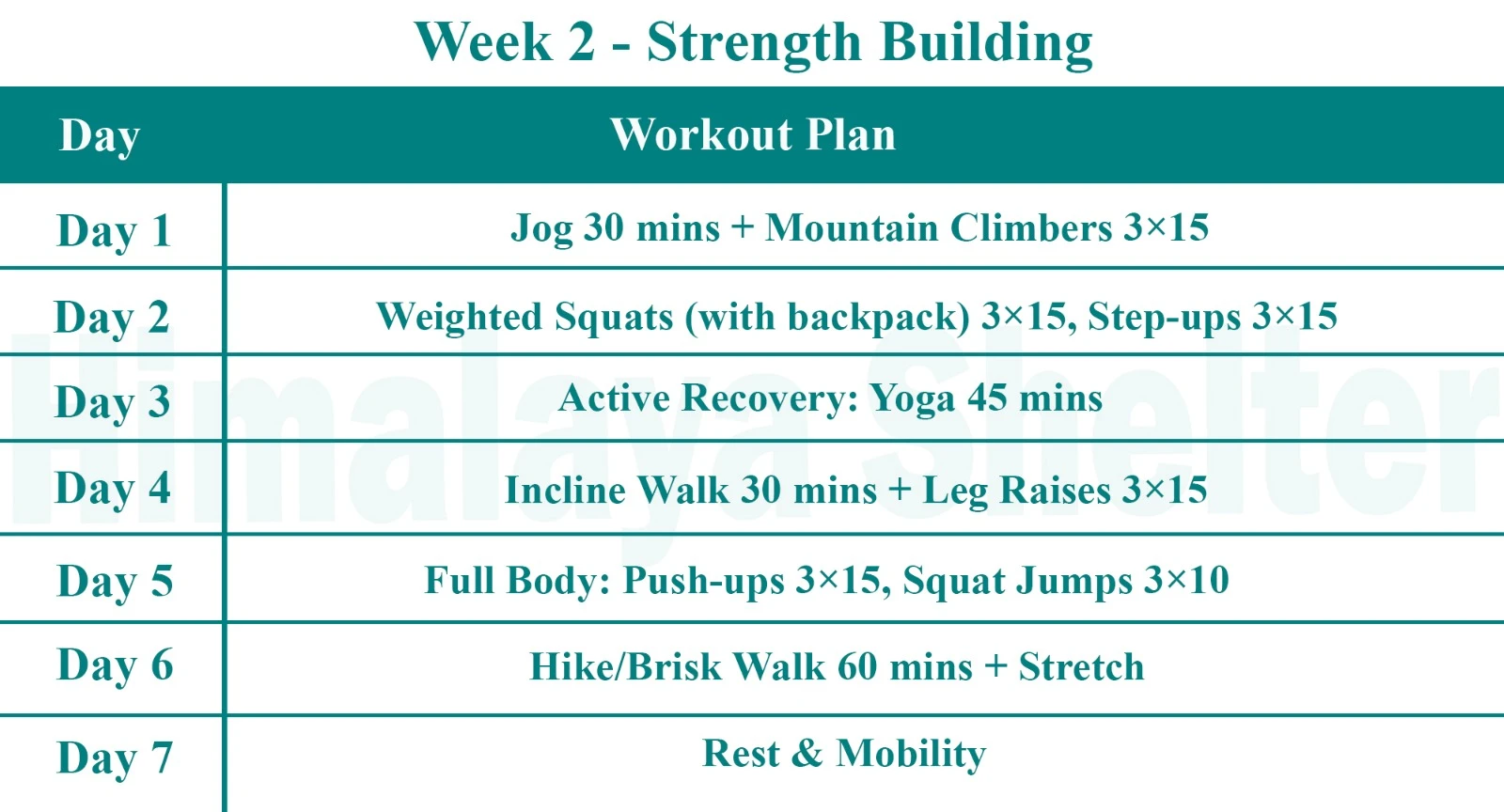
Strength Building

Power & Stamina
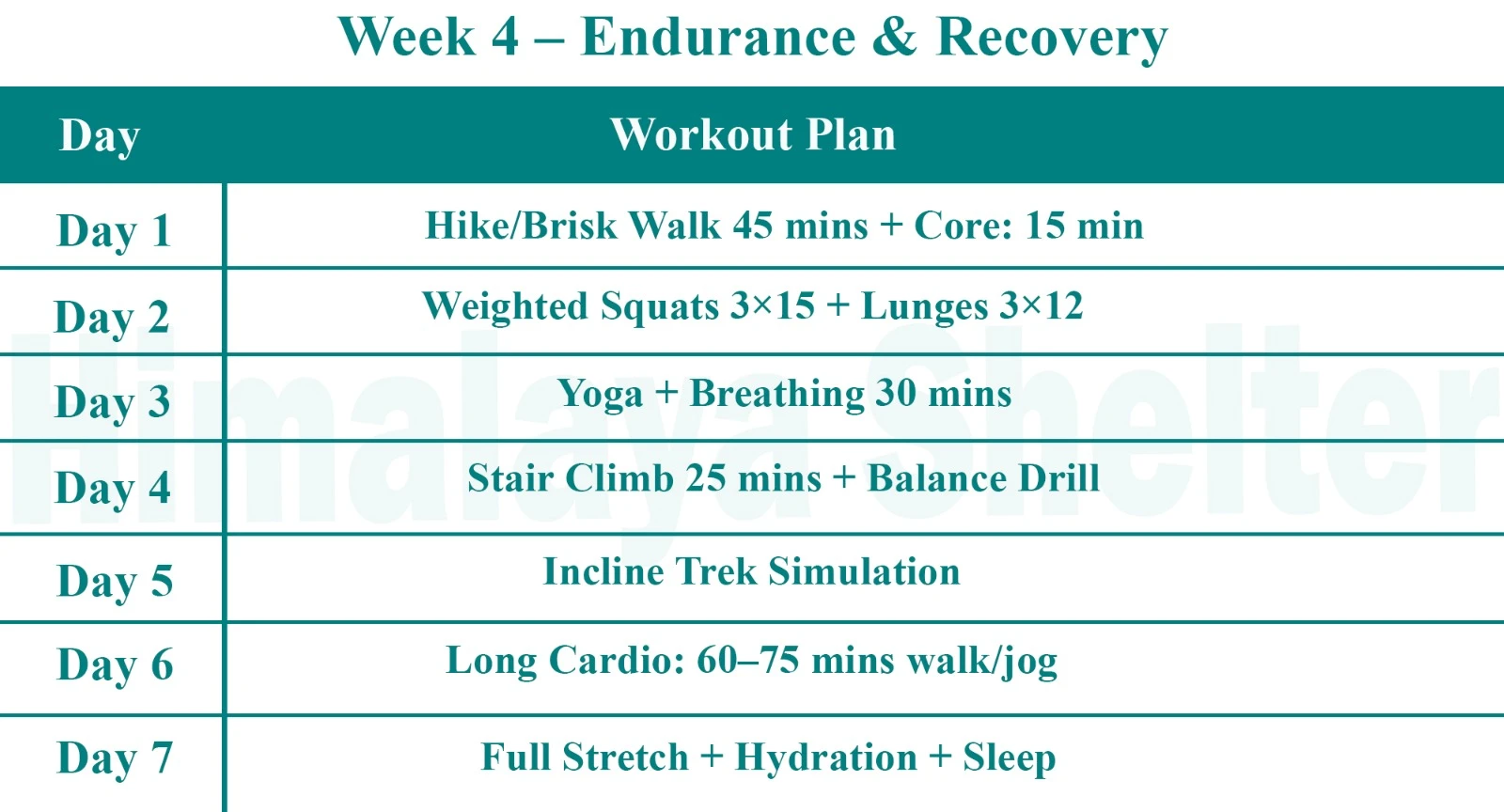
Endurance & Recovery
Warvan valley trek is a moderate to difficult trek. Counting a distance of around 78-80 Km, the participants usually cover about 12-15 Km each day. With a height of up to 14,495 feet, the trek requires high altitude hiking and excellent physical shape. The route includes challenging segments such as glaciers, steep lines and demanding climbing.
The Warwan Valley typically experiences cold winters with temperatures often dropping below freezing. Summers are milder with temperatures ranging from 15°C to 25°C. The monsoon season, from June to September, brings heavy rainfall, making it an ideal time for lush green landscapes.
Day 1: Drive from Srinagar to Panikhar
Drive: 185 km, 7-8 hrs
Altitude: 5,200 ft (1,585 m) – 10,700 ft (3,261 m)
Accommodation: Camping (Alpine Tents)
Meals: Dinner
You will start early in the morning from Srinagar and drive to Panikhar, which is located at a distance of around 220 km, approximately taking 8 to 9 hours to reach Panikhar. Initially, the drive will take you to Sonamarg along the beautiful view of the Indus River. Then, from Sonamarg, you proceed to Zoji La Pass, situated at an altitude of around 3,528 meters. After crossing the pass, you will pass through Dras and Kargil.
If you want to purchase something, then Kargil is the last place where you can buy your essential items. After the drive, you will reach your destination, Panikhar.

Day 2: Trek from Panikhar to Denora
Trek: 12-13 km, 8 hrs
Altitude: 10,700 ft (3,261 m) – 12,375 ft (3,772 m)
Accommodation: Camping (Alpine Tents)
Meals: Breakfast + Lunch + Evening Snacks + Dinner
After breakfast, you will start trekking towards Denora, located at an altitude of around 11,200 feet above sea level. The trek mostly follows the alongside of the river, involving a gradual ascent through meadows and forests, providing stunning views of the surrounding mountains. You will cover a distance of around 14 km and reach Denora by late afternoon. Before reaching the campsite, you have to cross the stream. The campsite is near the river, surrounded by a wide range of mountains and meadows.

Day 3: Trek from Denora to Kalapari
Trek: 3 km, 2-3 hrs
Altitude: 12,375 ft (3,772 m) – 12,850 ft (3,917 m)
Accommodation: Camping (Alpine Tents)
Meals: Breakfast + Lunch + Evening Snacks + Dinner
The trek starts with crossing streams; take off your shoes and be ready for the cold water, which numbs your feet. The trek involves crossing the 14,100 feet Marpo La Pass, offering stunning views of the surrounding peaks. You will descend through a beautiful valley and reach the campsite at Kalahari, located at an altitude of around 12,800 feet above sea level. Today’s distance is shorter than the other days; you can take an acclimatization walk to the glacial lake.

Day 4: Trek from Kalapari to Kaintal via Lomvilad Pass
Trek: 17 km, 12-13 hrs
Altitude: 12,850 ft (3,917 m) – 14,500 ft (4,420 m) – 11,550 ft (3,520 m)
Accommodation: Camping (Alpine Tents)
Meals: Breakfast + Lunch + Evening Snacks + Dinner
Start your day with the beauty of mountains and enjoy breakfast. Begin your trek, following moderate to difficult trails with narrow ridges, long moraine sections, and steep descents. The trail starts at the Kalapari campsite and consists of asymmetrical boulders and moraines. The trek involves crossing the 14,500 feet Kalichik La Pass, offering stunning views of the Nun and Kun peaks. Descend through a beautiful valley and reach the campsite at Kaintal.

Day 5: Trek from Kaintal to Humpet
Trek: 17 km, 8 hrs
Altitude: 11,550 ft (3,520 m) – 11,120 ft (3,389 m)
Accommodation: Camping (Alpine Tents)
Meals: Breakfast + Lunch + Evening Snacks + Dinner
The trek starts with a continuous ascent and descent alongside the river, opening up the beautiful landscape of the Warwan Valley. You will cross several small streams and reach the campsite at Sukhnai, located at an altitude of around 11,400 feet above sea level.

Day 6: Trek from Humpet to Sukhnai
Trek: 14 km, 8 hrs
Altitude: 11,120 ft (3,389 m) – 9,320 ft (2,841 m)
Accommodation: Camping (Alpine Tents)
Meals: Breakfast + Lunch + Evening Snacks + Dinner
The trek leads towards Sukhnai Valley, a beautiful area with lots of plant species, The trail starts with an ascent and a 4-hour descent, then continues to the junction where a river merges with Kaintal Nala, leading to Sheeshnag Lake The trail continues through the exotic Warwan Valley, crossing overhangings and gaining a stunning view of Sukhnai. The village takes 2 hours to reach, passing through farms with short fences.

Day 7: Trek from Sukhnai to Basmina/Chaudraiman
Trek: 16-17 km, 6-7 hrs
Altitude: 9,320 ft (2,841 m) – 8,350 ft (2,545 m)
Accommodation: Camping (Alpine Tents)
Meals: Breakfast + Lunch + Evening Snacks + Dinner
Start your last day of the Warwan Valley trek with an eye-catching view of grasslands and the Marwah River. Today’s trek involves a gradual descent through the beautiful Warwan Valley. You will cross several small streams; the trail from Sukhnai to Bashmina is moderate compared to other days. After a couple of hours, you will see the beautiful Rekenwas village, where you can meet local people and interact with them. The people of this village are very welcoming. Then, reach the campsite at Bashmina, located at an altitude of around 10,000 feet above sea level.

Day 8: Buffer Day
Accommodation: Camping (Alpine Tents)
Meals: Breakfast + Lunch + Evening Snacks + Dinner
This day is kept as a buffer day to accommodate any unforeseen circumstances such as bad weather or any other reasons that may cause delays in the trek

Day 9: Drive from Basmina/Chaudraiman to Srinagar
Drive: 155 km, 7-8 hrs
Altitude: 8,350 ft (2,545 m) – 5,200 ft (1,585 m)
Accommodation: Camping (Alpine Tents)
Meals: Breakfast + Lunch + Evening Snacks + Dinner
After breakfast, you will start your journey back to Srinagar. You will drive through the beautiful landscapes of the Warwan Valley and reach Srinagar by late afternoon. You will spend the night in a hotel in Srinagar.

Day 10: Buffer Day
Buffer Day: You have to pay us Rs. 4334 INR per day (Plus 5% GST) if you use the buffer day. The money will be collected by the Trek Leader only if we use the buffer day.
Inclusions
Our treks are specially designed by the experienced team at Himalaya Shelter, taking you on an adventure of a lifetime all while making you connect not only with the bountiful nature but also with yourself and with others on the trek with you creating wonderful memories which will last you a lifetime. All Himalaya Shelter treks are guided by experienced Trekkers having vast knowledge and experience of the region, providing with insightful information and stories pertaining to the region’s flora and fauna and the history of the region whilst the trek. It is safe to say that on successfully completing the trek, one will gain tremendous insight and experience along with lifetime memories.
- Transport support from Srinagar to Srinagar ( Pick-up location: Nishat Garden, Srinagar )
- Accommodation – At Base Camp, stay at a local homestay or guest house for one night each, which will give you an insight into the authentic lifestyle of the locals.( INR 5000 per person extra for single sharing throughout the trek )
On Trek stay in a 2-person Vango Halo Pro/A-Shape tent, which is to be shared by two trekkers, built to withstand extreme weather conditions and at the same time making you comfortable after a hard day’s trek. - Camping Equipment – specially designed sleeping bags that can withstand harsh weather conditions, foam mattresses. Other safety gear like microspikes, gaiters, an ice axe, and helmets will be provided.
- Medical Kit – our team will be equipped with an extensive medical kit, which our team is trained and experienced to use. Oxygen cylinders are used after they are thoroughly inspected throughout the Trek. Even campsites have large oxygen cylinders as backups.
- Permission - Forest entry charges for Indian nationals (Additional charges will be applicable for international tourists)
- Meals – Breakfast, packed lunch (on trek days), evening snacks, and dinner will be served. A hearty, delicious, and nutrition-filled Veg meals with egg preparation will be provided throughout the trek. (Jain and Vegan Food can also be arranged on prior notification.)There will be a dedicated Kitchen Tent along with a dining tent, which will have a dining table too.
- Our Team – A highly experienced and AMC-certified Trek Leader who will help ensure that the entire trek goes smoothly and safely while navigating the challenging conditions during the trek, and is skilled enough to navigate any medical emergency that can arise during the trek. Local and route Guides who are well-versed with the region and provide an in-depth insight into the local customs and knowledge of the flora and fauna endemic to the region. A dedicated Kitchen staff, which includes a Cook, a helper, and other support staff. There will also be porters and mules to carry common equipment.
- Cloakroom - We have a cloakroom facility available for extra luggage. Every trekker is permitted to leave their luggage behind at no charge.
Exclusions
- Personal expenses like tips, personal medicines, phone calls etc.
- Accommodation in Srinagar
- Travel Expenses - Travel expenses from your hometown to the mentioned Pick-Up Point are not included in the trek fee.
From the scheduled pick-up spot to the base camp, we have our own fleet of vehicles like Bolero, Innova, Dezire, or Tempo Traveler (12-seater). This is be shared by trekkers for a pre-decided amount. All vehicles are non-AC. - Personal Equipment - Any personal gear like jackets, shoes, cutlery, or backpacks are not included in the trek fee. We recommend renting them from our Rental Store for an affordable fee. This can be pre-arranged to avoid last-minute hang-ups.
- Offloading - We encourage carrying your backpack to get into the true spirit of trekking. However, if needed, you can opt to offload your personal luggage of up to 12 kgs for an additional cost of INR 400 per bag per day.
- Trek Insurance - A mandatory trek insurance fee is charged in addition to your trek fee. Since most medical insurance doesn’t cover adventure activities, trek insurance offers essential coverage, enhancing your safety without a significant financial burden.
- Buffer day on the trek - We have kept a buffer day on the trek to account for any weather-related delay. If this is utilized, you will need to pay an extra amount to your trek leader.
- Anything apart from inclusions
- Please carry a lunch box for a packed lunch/breakfast to avoid using polythene and Aluminium foil.
Keeping the Himalayas clean is our own responsibility. Reduce the use of Plastic when you are in the abode of the Sacred Himalaya. 🌱
Prepare for trekking by focusing on physical and mental readiness. Running, cardio exercises, and mental preparation are crucial. Understand the concept of layering for clothing, opting for quick-dry fabrics. Essential items include a medical kit, biodegradable soaps, and snacks. Invest in a hydration bag for regular treks to maintain consistent water intake and prevent dehydration. For more details visit the link- https://himalayashelter.com/blogs/how-to-prepare-for-a-trek-in-the-himalayas/
The trek is classified as moderately difficult, suitable for those with prior high-altitude trekking experience and strong physical stamina. It includes steep climbs, glacier crossings, and river passages.
The trek covers a distance of approximately 78 to 84 kilometers, with daily trails averaging around 20 kilometers.
Participants will witness a striking transformation—from Ladakh’s barren mountain terrain to Kashmir’s lush greenery, adorned with meadows, glacial valleys, and charming villages.
Adventurers have the chance to see fascinating creatures, including golden marmots, wagtails, and other unique Himalayan wildlife, especially in the valley meadows.
Notable glaciers along the route include the Kaintal Glacier and the Bracken Glacier, which are mesmerizing highlights.
The trek is best undertaken between July and August when the valley is accessible, as other times of the year are snow-covered.
To manage the demanding trails, trekkers should follow a training routine emphasizing stamina, strength, and flexibility for at least six to eight weeks before the trek.
This trail stands out for its pristine beauty, diverse landscapes, and the sense of solitude it offers due to limited commercial activity, making it perfect for seasoned trekkers seeking extraordinary escapades.
The trek involves challenging terrains, including steep ascents and river crossings. It's recommended to follow a fitness regime focusing on endurance, strength, and flexibility for at least 6-8 weeks before the trek.
Yes, trekkersWhat kind of wildlife can be spotted during the trek?
need to obtain permits as the trek passes through sensitive regions in Jammu and Kashmir. These permits can usually be arranged by your trekking agency.
Trekkers might encounter golden marmots, wagtails, and other unique Himalayan wildlife along the trail, especially in the meadows and valleys.
Accommodation is typically in tents provided by us. These are set up at designated campsites along the route.
Read More on Warwan Valley Trek
Photo Gallery








Treks by Categories
Treks By Month

Treks By Experience







